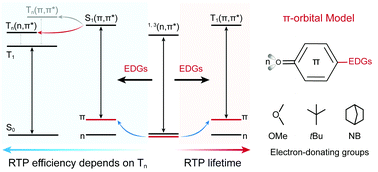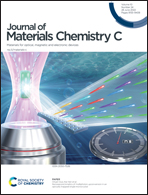A π-orbital model to study substituent effects in organic room-temperature phosphorescent materials†
Abstract
The substituent effect is a ubiquitous tool to improve the room temperature phosphorescence (RTP) of organic materials, but it remains unclear as to how to rationally manipulate the RTP performance. However, we establish a π-orbital model to unravel the substituent effect on the organic RTP materials, by using the hybrid quantum mechanics/molecular mechanics (QM/MM) model and N-Electron Valence State Perturbation Theory (NEVPT2). With the substitution of electron-donating groups (EDGs), the increase of the π-orbital energy level separates the hybrid or adjacent n/π-orbitals, converting S1 from (n, π*) to (π, π*) that produces the Tn-dependent intersystem crossing process, accounting for the diverse RTP efficiency caused by EDGs. Moreover, this change also transforms T1 (n, π*) to T1 (π, π*), suppressing the nonradiative relaxation of triplet excitons, thereby prolonging the RTP lifetime. Experimental validation was further performed for the predicted organic RTP molecule based on the π-orbital model. This model provides new guidelines to manipulate the RTP performance in organic materials.



 Please wait while we load your content...
Please wait while we load your content...